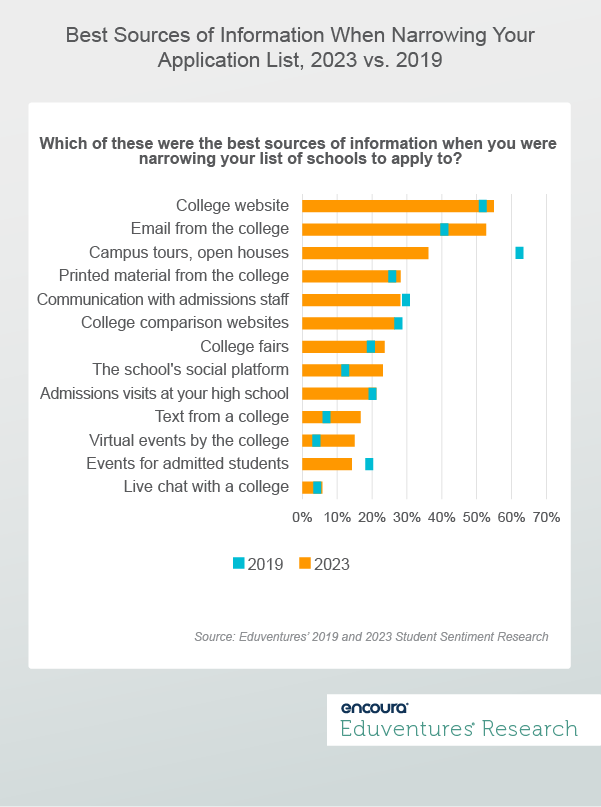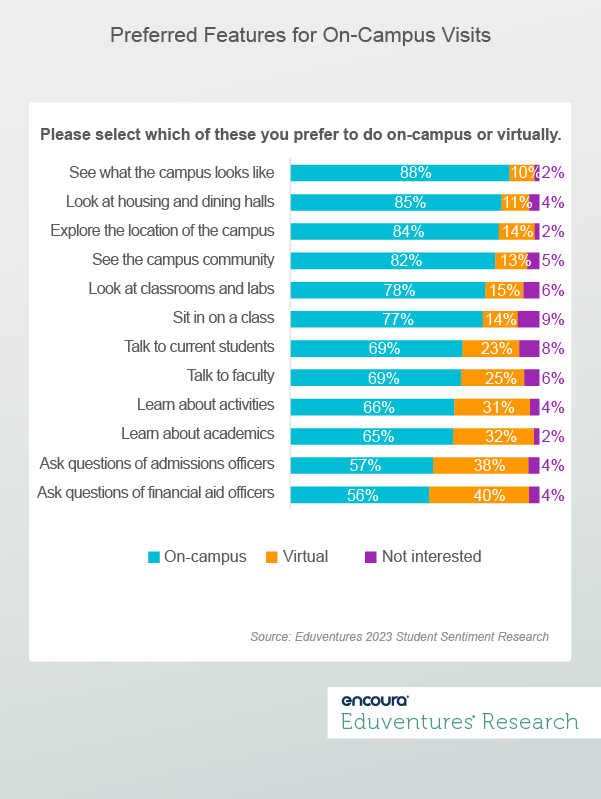June 14-16, 2023 | Boston, MA
Special Keynote Session: José Andrés
Once a reliable indicator of enrollment interest, campus visits have become somewhat of a wild card in student recruitment. Since the pandemic began to recede, many institutions have reported lackluster attendance, even among admitted students. Eduventures’ most recent Student Sentiment Research™ indicates that 82% of high school sophomores and juniors report plans to visit college campuses before they apply. Yet only 48% of seniors say they did.High Intentions, Low(er) Value
The pandemic left college-bound high school students longing to experience the schools they were considering applying to. Finally, campus visits are back, but it seems that students no longer hold them in high regard. Figure 1 shows the best information sources for narrowing your application list, according to prospective students.
What Is the Purpose of a Campus Visit?
Campus visits generally consist of an information session followed by a guided tour, with most institutions assuming a general lack of knowledge among visiting students. Our Student Sentiment Research sought to understand what information students prefer to receive during these events and what can be conveyed virtually (Figure 2).
The Bottom Line
It is important to point out that despite relatively low participation in official campus visits before applying, Eduventures research also suggests that the vast majority of seniors, about 80%, do eventually visit at least one college campus prior to attending college. Gen Z is quite savvy at finding information online. And when it comes to campus visits, they seek answers that go beyond what websites, online message boards, or even ChatGPT can provide: Will I be happy here for the next four years? It is no surprise, then, that many students opt for unofficial campus visits—especially in early search. This allows them to explore the campus freely based on their own interests, rather than being influenced by the institutional narrative. Traditional campus visits, however, still tend to provide an abundance of general information, resulting too-often in a generic, sometimes uninspiring experience. It’s time to reimagine the formal campus visit and enhance the experience of your prospects. Here are two key strategies:- Personalize the campus experience. Tailor the visit to student interests by gathering information on their preferences through your registration form or a follow-up email. Group visiting students with similar interests and create a more personalized experience for key student segments.
- Share college facts beforehand. Since most students have already researched basic fit factors like available majors and cost, provide this type of information in advance through quick-fact sheets or FAQs on your website. During the visit, tour guides and info session hosts should focus on providing a stellar visit experience while being prepared to answer any additional questions if they arise without lengthy monologues.
Never Miss Your Wake-Up Call
Learn more about our team of expert research analysts here.
Eduventures Senior Analyst at Encoura
Contact
For a teenager, the college decision looms as a complex make-or-break moment, a pivotal turn on an imagined path to adulthood. Understanding the decision-making factors, along with perceptions around your institution, college, and more, will help you make data-driven decisions to stand out from your competition.
Thursday June 15th, Eduventures Summit, 12:30pm - 1:45pm
Johanna Trovato, Eduventures Principal Research Analyst and June Claughton, Eduventures Senior Quantitative Research Analyst
Never Miss Your Wake-Up Call
Learn more about our team of expert research analysts here.

